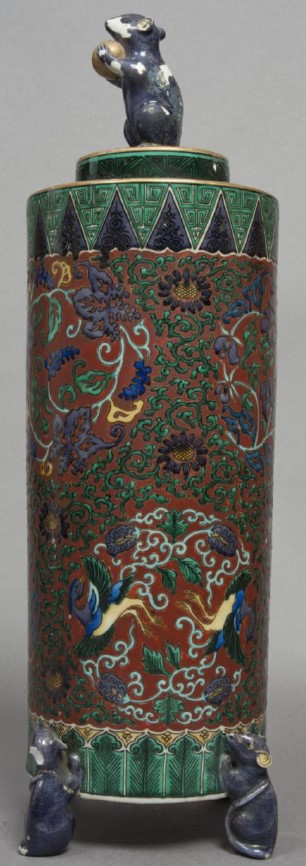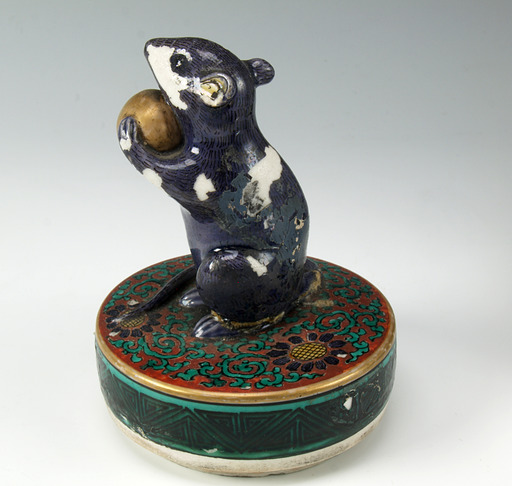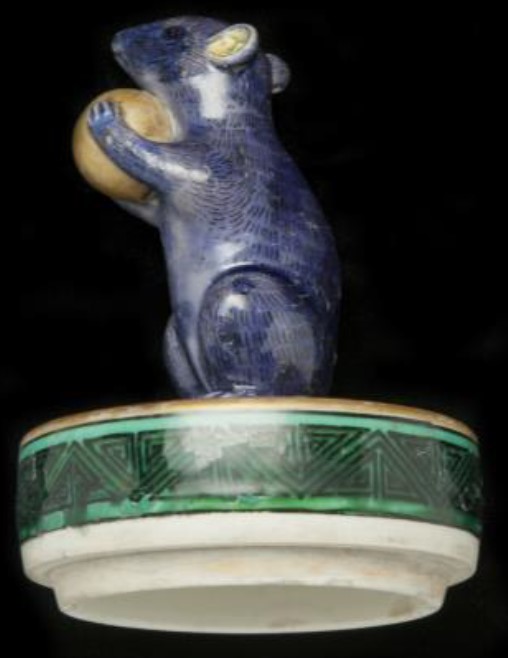Decorative Vase
Object

A tall porcelain incense burner with a cover, and decorated with brown, green, yellow, blue and aubergine glaze in the five-colours style to imitate Cloisonné enamelling. The incense burner has a straight body, a folded mouth and stands on four legs.
Entwining chrysanthemum decorates the mouth of the vessel and the body outside of the circular decorative panels, in a repeating pattern. Just below the mouth, there are alternating triangle panels of archaic fret and scrolls in imitation of designs of archaic bronze vessels.

The main body has six reserved panels in circular form, decorated with pair of phoenixes and flower sprays. Around the base of the vessel there is a band of banana leaf pattern with the heads in the shape of Ruyi lappet.
The legs of the vessel are shaped into mice, and the cover of the vessel also displays a mouse carrying a gilt pearl. The surface of the cover is decorated with twining chrysanthemum, and the sides are decorated with geometric triangles.
Condition
- Signs of dirt on the surface of the vessel
- Excess, discoloured adhesive is visible on several historic joins
- There is evidence of past restoration, which does not blend appropriately with the original material.
Conservation

An initial clean of the object was undertaken using cotton wool swabs with an appropriate cleaning solution in order to remove the surface dirt. As the historic repairs to the vessel were deemed inappropriate, the decision was made to remove them. As such, the areas of overpainting were removed using an appropriate solvent, which removed the paint, but didn’t damage the ceramic. The old plaster fills were also removed though they were unable to be removed solely using a solvent solution and so were softened with a suitable solvent, and then removed carefully using a scalpel.

It was evident from the initial condition examination that a number of previous repairs had been secured in place using an animal glue, as adhesive overspill was visible in several areas on the vessel. This animal glue had deteriorated over time, as there were signs of yellowing and it was considered that the old joins could fail in the future. As several of the joins were structural in nature, the decision was made to remove all of the old adhesive and take down the old joins. This was achieved using deionised water, as the majority of animal glues are highly soluble in water.
The joins were then re-adhered using a suitable ceramic adhesive that was long term stable, in order to ensure the stability of the object. These joins were held in place using electrical tape in order to prevent the pieces slipping as the adhesive cured and causing a ‘step’ which would require correction before additional pieces could be adhered.
The areas of missing surface material were infilled using an appropriate ceramic filler, and smoothed in order to ensure the fill was flush with the original surface. These fills were left to cure before being painted with acrylic paints to match the original colours of the vessel. Following colour matching, the fill areas were coated with a porcelain glaze in order to match the original gloss of the ceramic.
